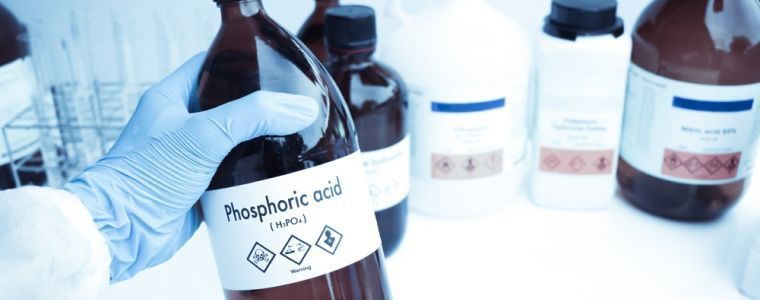Essential Chemicals for Water Treatment: What Every Engineer Should Know
Water is one of the most valuable resources in the world, yet it rarely comes in a form that is safe or suitable for direct use. From municipal water supplies to industrial cooling systems and even domestic applications, effective water treatment is essential for protecting public health, ensuring process efficiency, and preserving the environment. At the heart of this process lies chemistry.
Chemical treatment plays a critical role in removing contaminants, preventing scaling and corrosion, disinfecting pathogens and maintaining overall water quality. Without the right chemical balance, treatment systems can fail, leading to health hazards, costly equipment damage, or regulatory non-compliance.
For engineers, understanding these essential chemicals is not just a matter of technical knowledge - it is a professional necessity. Whether designing a
water treatment plant, optimizing an industrial process, or ensuring sustainable practices, engineers must understand which chemicals are crucial, how they function, and why they are indispensable in achieving safe, reliable, and high-quality water.
Why Chemicals Are Critical in Water Treatment
Water treatment relies on a combination of physical, chemical and biological processes, but chemicals often serve as the backbone of these systems. Physical methods, such as filtration and sedimentation, can remove larger particles, while biological treatment is highly effective in breaking down organic matter. However, neither of these methods alone can guarantee safe, high-quality water. This is where chemical treatment becomes indispensable.
Chemicals are used to target a wide range of impurities that other methods cannot fully address. Coagulants and flocculants help remove suspended solids, while disinfectants eliminate harmful pathogens that pose serious health risks. Corrosion and scaling inhibitors protect pipes, boilers and cooling systems, extending equipment life and ensuring operational efficiency. To ensure stable and reliable water quality, oxidizing agents, softening chemicals, and pH regulators are applied across municipal, industrial and domestic systems.
The benefits of chemical treatment are clear. First, it increases efficiency by achieving results quickly and reliably, even in large-scale systems. Second, it is often more cost-effective than relying on extensive physical infrastructure alone. Finally, chemical treatment ensures compliance with stringent environmental and health regulations, which is critical for industries and municipalities alike.
In short, while physical and biological methods play important roles, chemicals remain the most versatile and powerful tools in the water treatment process. They not only safeguard water quality but also support sustainable and cost-effective operations, making them essential knowledge for every engineer involved in water management.
Categories of Water Treatment Chemicals
Water treatment involves a wide range of chemicals, each serving a specific purpose to ensure that water is safe, efficient to use and compliant with regulations. These chemicals can be grouped into several key categories, based on their function in the treatment process.
Coagulants and Flocculants
Chemicals such as aluminum sulfate (alum), ferric chloride, and specialized polymers are used to destabilize and aggregate fine suspended particles. This process forms larger clumps, or flocs, which can then be removed more easily through sedimentation or filtration.
Disinfectants
To eliminate harmful microorganisms, disinfectants such as chlorine, chloramines, ozone and UV-assisted chemical agents are employed. They are critical for preventing the spread of waterborne diseases and ensuring public health.
Corrosion and Scale Inhibitors
Phosphates, silicates, and sodium hexametaphosphate are common chemicals that protect metal surfaces in pipelines, boilers and cooling systems. By minimizing corrosion and scale buildup, they extend equipment lifespan and reduce maintenance costs.
pH Adjusters and Neutralizers
Maintaining proper pH is essential for both water quality and system performance. Lime, caustic soda, sulfuric acid, and carbon dioxide are commonly used to adjust acidity or alkalinity, helping to stabilize treatment processes.
Specialty Chemicals
In more complex treatment scenarios, biocides, antifoaming agents, and strong oxidizers are applied. These specialty chemicals address unique challenges, such as controlling microbial growth in industrial systems or preventing foaming in wastewater treatment.

Essential Chemicals Every Engineer Must Know
Engineers working in water treatment must be familiar with a core group of chemicals that form the foundation of most treatment processes. Each has a specific role in ensuring water safety, reliability, and compliance with standards.
Chlorine – The Universal Disinfectant
Chlorine remains the most widely used disinfectant in water treatment worldwide. It is highly effective against bacteria, viruses, and other pathogens, making it a cornerstone of municipal water safety. Beyond its disinfecting power, chlorine also provides a residual effect, meaning it continues to protect water as it moves through distribution systems.
Alum – Classic Coagulant in Water Treatment
Aluminum sulfate, commonly known as alum, is a traditional but still widely used coagulant. It works by neutralizing the charges of suspended particles, allowing them to bind together into larger flocs that can be removed through settling and filtration. Its cost-effectiveness and proven performance make it a staple in water treatment plants.
Activated Carbon – For Taste, Odor and Chemical Removal
Activated carbon is unique among treatment agents for its ability to adsorb a wide range of organic compounds, chlorine by-products, and even trace contaminants like pesticides. It is especially valuable for improving water taste and odor, which directly affects consumer satisfaction.
Lime – Key for pH Control and Hardness Removal
Lime (calcium hydroxide) plays a dual role in water treatment. It is commonly used to adjust pH levels, creating a stable environment for other chemical processes. Additionally, lime helps reduce water hardness by precipitating calcium and magnesium salts, protecting equipment and improving water usability.
Polymeric Coagulants – Modern Alternatives to Alum
While alum is effective, polymeric coagulants are gaining popularity due to their higher efficiency and lower sludge production. Synthetic and natural polymers can target specific impurities, often requiring smaller doses and reducing overall treatment costs.
Sodium Bisulfite – Dechlorination Agent
In systems where excess chlorine needs to be neutralized, sodium bisulfite is a reliable choice. It removes chlorine residuals before water is discharged or used in sensitive processes, protecting aquatic life and preventing unwanted chemical reactions in industrial applications.
Factors Engineers Should Consider When Selecting Chemicals
Choosing the right chemicals for water treatment is not a one-size-fits-all process. Engineers must evaluate several factors to ensure the selected treatment strategy is both effective and sustainable.
Water source and composition play a critical role. Surface water often contains higher levels of organic matter and microorganisms, requiring stronger disinfection
and coagulation, while groundwater may have elevated mineral content that demands pH adjustment or softening. Understanding the raw water profile is the first step toward selecting appropriate treatment chemicals.
Regulatory compliance and safety standards must always guide decision-making. Drinking water, industrial water, and
wastewater treatment are all subject to strict national and international guidelines. Engineers must ensure that chosen chemicals not only meet performance requirements but also align with health and environmental regulations.
Chemical interactions and compatibility are another key consideration. Some chemicals can interfere with each other, reducing effectiveness or producing harmful by-products. Proper dosing and sequencing help avoid these issues and maintain treatment efficiency.
Environmental impact and sustainability are increasingly important. Where possible, engineers are encouraged to select chemicals with lower ecological footprints, minimize sludge generation, and adopt practices that reduce long-term environmental harm.
Finally, the cost vs. performance balance cannot be ignored. While cheaper chemicals may lower immediate expenses, they can result in higher operational costs due to inefficiency, equipment damage, or compliance penalties. Striking the right balance ensures both economic and technical success.
By carefully weighing these factors, engineers can design treatment systems that are safe, efficient and resilient for the future.
Safety and Handling Guidelines
Working with water treatment chemicals requires strict attention to safety, as many of these substances can be hazardous if misused. Proper guidelines help protect operators, engineers and the environment.
Personal protective equipment (PPE) is the first line of defense. Gloves, safety goggles, face shields, and chemical-resistant clothing should always be worn when handling corrosive, oxidizing, or reactive chemicals. Respiratory protection may also be necessary in areas with fumes or dust.
Storage best practices are equally critical. Chemicals should be kept in clearly labeled, compatible containers, away from direct sunlight and sources of heat. Incompatible substances, such as acids and bases, must be stored separately to avoid dangerous reactions. Secondary containment systems are recommended to prevent leaks from spreading.
Spill management and emergency protocols must be in place before incidents occur. Quick access to spill kits, neutralizing agents, and eyewash stations can significantly reduce risks. Facilities should also maintain clear procedures for containment, cleanup, and reporting of chemical spills.
Finally, training and awareness are essential. Engineers and operators need ongoing education on safe handling practices, emergency response, and correct dosing techniques. Regular drills and safety audits reinforce preparedness and ensure compliance with occupational health standards.
By prioritizing safety and handling, organizations not only protect their personnel but also maintain reliable and responsible water treatment operations.
Future Trends in Water Treatment Chemicals
The field of water treatment is rapidly evolving, driven by environmental concerns, regulatory pressures and technological innovation. Several trends are shaping the future of chemical use in this sector.
One of the most significant shifts is the move toward green chemistry and eco-friendly alternatives. Researchers and manufacturers are developing biodegradable coagulants, plant-based polymers, and less hazardous disinfectants that reduce ecological impact while maintaining treatment efficiency. This transition supports sustainability goals and helps utilities meet stricter environmental standards.
Another promising development is the application of nanomaterials and advanced polymers. Nanoparticles offer high surface area and reactivity, making them effective for removing heavy metals, organic pollutants, and even emerging contaminants such as pharmaceuticals. Similarly, next-generation polymers are being engineered to improve selectivity, reduce sludge generation, and lower chemical consumption.
Finally, the integration of automation and AI for dosage optimization is transforming plant operations. Smart sensors and predictive algorithms can monitor water quality in real time and adjust chemical dosing with precision. This not only improves treatment outcomes but also minimizes waste, lowers costs, and enhances regulatory compliance.
Together, these innovations point to a future where water treatment is safer, more efficient, and more sustainable, empowering engineers to deliver clean water while reducing the environmental footprint of chemical use.
Conclusion
The intricate field of water treatment is fundamentally dependent on the precise and judicious application of various chemicals. As we've explored, coagulants like aluminum sulfate and ferric chloride, along with flocculants, are indispensable for aggregating suspended solids, thereby facilitating their removal. Disinfectants, particularly chlorine and its derivatives, are crucial for neutralizing harmful pathogens and safeguarding public health.
Furthermore, pH adjusters and corrosion inhibitors are vital for optimizing treatment processes and protecting infrastructure. The effective use of these chemicals requires a deep understanding of their properties, dosages, and potential byproducts. For every engineer, this knowledge is not merely academic; it is the cornerstone of designing efficient, sustainable and safe water treatment systems. The ultimate goal is to provide a reliable supply of clean water, and this is a responsibility that hinges on a mastery of these essential chemical tools.
















